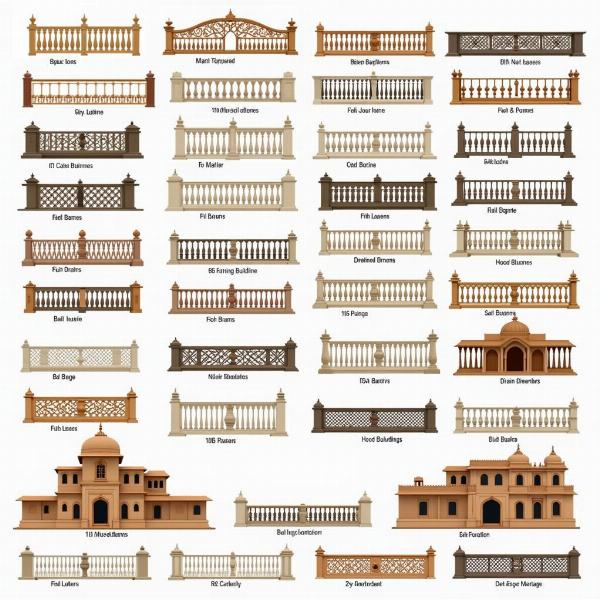Understanding architectural terms can be tricky, especially when navigating different languages. If you’re looking for the “baluster meaning in Hindi,” you’ve come to the right place. This guide will delve into the various Hindi translations, cultural contexts, and related architectural elements associated with balusters. We’ll explore not only the direct translations but also the nuances of their usage in Indian architecture and design.
Exploring the Hindi Translations of Baluster
The most common Hindi word for baluster is खंभा (khambhā), which generally translates to “pillar” or “post.” While this is a widely accepted term, it doesn’t fully capture the specific meaning of a baluster as a short, decorative pillar within a railing. A more precise translation could be छोटा खंभा (chhoṭā khambhā), meaning “small pillar.”
Other terms used depending on the specific context and regional variations include:
- तराशा हुआ खंभा (tarāshā huā khambhā): Carved pillar, emphasizing the decorative aspect.
- बाड़ का खंभा (bāṛ kā khambhā): Fence pillar, highlighting its function within a railing.
- स्तंभिका (stambhikā): A more formal and literary term derived from Sanskrit, also meaning “small pillar.”
Balusters in Indian Architecture: A Cultural Perspective
Balusters in India, much like elsewhere, serve both functional and aesthetic purposes. They provide support for railings, ensuring safety, while also adding an element of beauty and artistry to structures. Traditional Indian architecture often features ornately carved balusters, reflecting the rich artistic heritage of the region. These carvings can depict mythological figures, floral patterns, or geometric designs, showcasing the craftsmanship and cultural significance imbued in these seemingly simple architectural elements.
Beyond the Basics: Related Architectural Terms
Understanding the context of balusters within a larger architectural framework requires familiarity with related terms. For instance, the entire railing system, including the balusters, handrail, and base, is often referred to as बाड़ (bāṛ) or रेलिंग (reling). The top rail is known as मुख्य पट्टी (mukhya paṭṭī) or हैंडरेल (handrail), while the supporting structure at the bottom is called आधार (ādhār) or बेस (base). Knowing these related terms helps in a more comprehensive understanding of architectural discussions and descriptions.
 Examples of Indian Balustrades
Examples of Indian Balustrades
Why is knowing “Baluster Meaning in Hindi” Important?
Knowing the correct terminology is crucial for clear communication, especially in fields like architecture, construction, and design. Whether you’re discussing a renovation project with a local contractor or researching historical architectural styles, using the appropriate Hindi words ensures accuracy and avoids misunderstandings. It also demonstrates respect for the local language and culture.
Baluster Materials and Styles in India
Indian balusters showcase a wide range of materials and styles. Traditionally, wood, stone, and metal have been popular choices. Intricate wood carvings are often seen in older homes and temples. Stone balusters, especially those made of marble or sandstone, are common in grander structures. Metal balusters, including wrought iron and cast iron, offer durability and intricate designs. Modern architecture also incorporates materials like concrete and composite materials for balusters, offering a blend of functionality and contemporary aesthetics.
Conclusion: More Than Just a Pillar
The “baluster meaning in Hindi” encompasses more than just a simple translation. It reflects the cultural significance and artistic expression embedded in Indian architecture. Understanding the various terms and their nuances allows for a deeper appreciation of the rich architectural heritage of India. Whether you are an architect, a homeowner, or simply curious about Indian design, knowing the correct terminology enhances your understanding and communication.
FAQ
- What is the simplest Hindi word for baluster? खंभा (khambhā)
- What is a more precise term for a decorative baluster? तराशा हुआ खंभा (tarāshā huā khambhā)
- What is the Hindi word for the entire railing system? बाड़ (bāṛ) or रेलिंग (reling)
- What materials are commonly used for balusters in India? Wood, stone, metal, concrete, and composite materials.
- Why is it important to know the correct Hindi translation for baluster? For clear communication and cultural sensitivity in architectural discussions.
Meaning-Hindi.in is your trusted partner for all your Hindi translation needs. We specialize in various domains, including business, legal, technical, website localization, and academic translations. Our team of expert linguists ensures accurate and culturally sensitive translations, bridging the language gap for businesses and individuals alike. Whether you need to translate balister meaning in hindi or understand the parapet meaning in hindi, we provide high-quality, professional translation services. Contact us at [email protected] or call us at +91 11-4502-7584. Meaning-Hindi.in is committed to delivering exceptional language solutions.